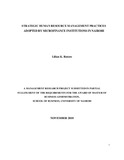| dc.description.abstract | The adoption of Strategic Human Resource Management Practices enables strategic decisions to be made by management that have major and long term impact on behavior and success of the organizations. This is achieved by ensuring that the organizations have skilled, committed and well motivated employees they need to achieve their objectives. Microfinance Institutions are expected to play a vital role in the realization of the Kenya Vision 2030 which localizes the United Nations' Millennium Development Goals. Despite this noble role, a closer look at the operations of many MFIs reveals that they all face challenges related to strategic human resources management practices. The objective of the study was to establish the strategic human resources management practices adopted by the microfinance institutions in Nairobi. The findings of the study will be of benefit to financial institutions, the human resource practitioners and the seekers of knowledge in the field.
The study adopted a descriptive research design. The study population consisted of 40 MFIs registered under AMFI. (The Association of Microfinance Institutions) AMFI is a member Institution that was registered in 1999 under the societies Act by the leading Microfinance Institutions in Kenya to build capacity of the micro finance industry in Kenya. Since the entire . population of MFIs to be studied was sufficiently small, the researcher used the census method.
The study was carried out through census survey because of the cross-sectional nature of the data to be collected. The study used primary data in data collection. The primary data was collected through the use of a structured questionnaire. The target group included Human Resource departments heads or HR section heads. The data was analyzed using descriptive statistics. The descriptive statistics findings were presented in simple tabular analysis, which formed the basis of quantitative analysis of the collected data.
From the findings, the study found out that Microfinance institutions in Nairobi have adopted Strategic human resource management practices to a great extent. The adoption of strategic human resource management practices in MFI's creates competitive advantage for the institution, increased productivity and higher quality of work life that's leads to the attainment of greater profitability.
The study concluded that the other strategic management practices adopted by the microfinance were recruitment and selection, training and development, formal grievance procedure, employee motivation and commitment, reward management, compensation and performance management. From the findings and conclusion, the study recommends that organizations should adopt strategic human resources management practices. When these are put in place the people through whom the goals of an organization are accomplished are empowered. | en_US |

